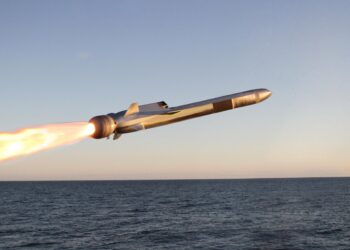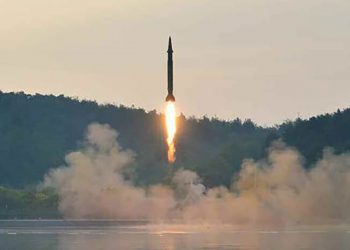The May 18 edition of The New York Times contained an article (“Review Cites Flaws in U.S. Antimissile Program”) detailing a study conducted by Dr. Theodore Postol and Dr. George Lewis published in the May issue of Arms Control Today (ACT). The study called into question the test record of the Standard Missile-3 (SM-3) sea-based interceptor that is designed to intercept and destroy short- to medium-range ballistic missiles. The ACT article stated that successful intercepts during tests of the SM-3 actually “missed” targets and should not have been assessed as successful.
The Missile Defense Agency strongly refutes this allegation. The SM-3 program is one of the most successful programs within the Department of Defense, with operational interceptors now deployed aboard U.S. Navy ships. These ships range throughout the world’s oceans, providing an effective, reliable defense against short- to medium-range ballistic missiles. An extensive, operationally realistic test program is continuing to further improve and enhance the capabilities of the SM-3 element of the Ballistic Missile Defense System.
For whatever reasons, The New York Times chose not to include information provided to the newspaper by MDA to respond to allegations by Dr. Postol and Dr. Lewis which would have provided accuracy, clarity and context to the article.
Some examples:
**“The system is highly fragile and brittle and will intercept warheads only by accident, if ever,” said Dr. Postol…”
FACT: Not included in the Times article from information provided to the reporter that from 1991 through 2010 the Missile Defense Agency has conducted 66 full scale hit-to-kill lethality sled tests and 138 sub-scale hit-to-kill light gas gun tests covering all MDA interceptor types against nuclear, unitary chemical, chemical submunitions, biological bomblets and high-explosive submunition threats. Eighteen of these tests were specifically devoted to the current SM-3 kinetic warhead system. This extensive database of lethality testing has conclusively demonstrated that MDA’s weapon systems are highly lethal against ballistic missile threats when they engage within their accuracy and velocity specifications. After successful completion of early developmental tests, the test program progressed from just “hitting the target” to one of determining lethality and proving the operationally configured Aegis SM-3 Block I and SM-3 Block 1A system. These tests were the MDA’s most comprehensive and realistic test series, resulting in the Operational Test and Evaluation Force’s October 2008 Evaluation Report stating that Aegis Ballistic Missile Defense Block 04 3.6 System was operationally effective and suitable for transition to the Navy.
**“Even so, the Pentagon later admitted that four of the 10 analyzed flight tests carried no mock warheads at all.”
FACT: As stated to the Times reporter, three of the four tests cited were the very first intercept tests conducted in 2002 using a prototype SM-3. The objective of these early developmental tests was to determine if an SM-3 interceptor launched from an Aegis ship could hit a ballistic missile in flight. In each test the target was intercepted and destroyed. Since they were the very first intercept tests of the SM-3, specific lethality (hitting the warhead) was not a test objective. Target warheads used in missile defense tests are very complex, expensive assets, and since specific lethality wasn’t a test objective, mock warheads were not used in these very early developmental tests. The fourth test cited in the Times article was also not a test of specific lethality. All other SM-3 intercept tests used mock warheads that were threat-representative and extensively instrumented to obtain target data and to determine the extent of their destruction.
**“The dispute between the academics and the Pentagon centers on whether it is enough for a speeding interceptor to hit the body of a spent rocket moving through outer space or whether it must hit the attached warhead. Dr. Postol says the SM-3 interceptor must shatter the warhead directly, and public statements of the Pentagon agency seem to suggest that it agrees. “The interceptors,” the agency Web site says in its basic explanation of antimissile goals, “ram the warhead at a very high closing speed, destroying the target.”
FACT: Although MDA provided extensive information, the Times article failed to mention that the assessment by Dr. Postol and Dr. Lewis examined only tests using “unitary” targets, whereby the warhead and booster rocket do not separate, and represents short-range “SCUD” missile technology. In tests against unitary targets, the SM-3 has been very successful, hitting the target missile at speeds up to 8,000 miles per hour, generating a tremendous amount of energy that caused catastrophic failure of the target missile. The Times article also didn’t mention that five of six intercept tests involving separating targets—when the warhead separates from the booster rocket, and representative of medium-range “No Dong” technology—were very successful, with the SM-3 directly colliding with the target warhead as it traveled through space, a much smaller and challenging target compared with a unitary target.
**“The study examined video images that the SM-3 kill vehicle took a split second before striking the target and that the Missile Defense Agency subsequently made public. The analysis looked at 10 tests between 2002 and 2009 — all of which the agency hailed as successful intercepts.”
FACT: Dr. Postol and Dr. Lewis stated in their article that the video and still images of the intercept were the “final” frame before interceptor impact. This isn’t true; they were only images that were publicly released. Although MDA provided this information to the reporter, the Times chose not to report that subsequent sensor views showed exactly where the interceptor collided with the target—within inches of the planned impact point—and that these images were not released to preclude potential adversaries from determining the exact impact point.









